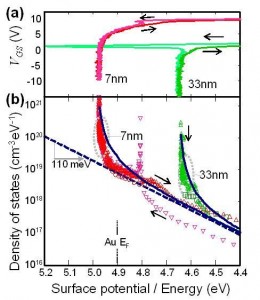Research
Direct measurements of energetic disorder
K.Celebi, K.M.Milaninia, P.J.Jadhav, M. Bora and M.A. Baldo
Sponsorship: Dupont-MIT alliance
Energetic disorder in organic semiconductors creates important differences in the electronic properties of conventional and organic semiconductors. Consequently, charge transport models for organic semiconductors rely on knowledge of the density of states (DOS) as a function of energy. The tail of the DOS is particularly important since it dominates the percolation paths for carriers in most devices. But the tail of the DOS is not generally available with sufficient resolution. Instead, an exponential[1] or Gaussian[2] DOS (density of states) is typically assumed in most calculations. There are existing techniques for measuring the DOS such as UPS and IPES measurements,[3] or thermally stimulated luminescence. However, these techniques yield either low resolution data or require complicated models for interpretation.
Recently, Tal et al [4] have extracted high resolution DOS measurements using Kelvin probe force microscopy (KPFM). They examined the hole transport material N,N’-diphenyl-N,N’-bis(1-naphthyl)-1,1’-biphenyl–4,4’-diamine (α-NPD) and reported both a central Gaussian DOS and an exponential tail. In this work, we adopt the approach of Tal, et al. and apply it to the common hole transport material copper phthalocyanine (CuPC). CuPC is employed as the channel material in a field effect transistor. Both the source and drain of the transistor are grounded, fixing the absolute position of the Fermi level in the transistor channel. Bias applied to the gate is used to modulate the charge density in the channel. But since the position of the Fermi level is fixed by the source and drain, gate-induced population and depopulation of the CuPC highest occupied molecular orbital (HOMO) requires modulation of the channel potential. For example, as the gate potential is made more negative, holes populate the tail of the distribution of CuPC HOMO states. This is accommodated at a constant Fermi level by pushing the potential of the channel up relative to the source and drain. For a small DOS at the Fermi level, the change in channel potential is rapid. For a large DOS at the Fermi level, the channel potential is pinned and varies very slowly.
In contrast to Tal, et al., we find only an exponential DOS with a characteristic energy of 0.11eV over at least a 0.5eV range of energies in the tail of the CuPC HOMO. The range of data is sufficient to confirm that, in CuPC at least, the DOS is not Gaussian, as is commonly expected. The range of data is limited for large DOS by non-uniform channel potentials and hysteresis for small DOS. We find, however, that both limits are alleviated for thin channel potentials.
Fig. 1 (a) The surface potential above a CuPC-based field effect transistor as a function of gate bias. Data is shown for both 5nm and 25nm thick CuPC channels. Note the large hysteresis in the 25nm thick device, probably due to the storage of negative charges at low gate bias. (b) Measured and simulated density of states (DOS). The data is consistent with an exponential density of states with characteristic energy of 0.11eV.
Relevant Publications
- Lampert, M. A. & Mark, P. Current Injection in Solids (Academic Press, NY, 1970).
- Bassler, H. Charge transport in disordered organic photoconductors – A Monte Carlo simulation study. Physica Status Solidi B-Basic Research 175, 15-56 (1993).
- Aristov, V. Y., Molodtsova, O. V., Maslyuk, V., Vyalikh, D. V., Zhilin, V. M., Ossipyan, Y. A., Bredow, T., Mertig, I. & Knupfer, M. Electronic structure of pristine CuPc: Experiment and calculations. Applied Surface Science 254, 20-25 (2007).
- Tal, O., Rosenwaks, Y., Preezant, Y., Tessler, N., Chan, C. K. & Kahn, A. Direct determination of the hole density of states in undoped and doped amorphous organic films with high lateral resolution. Physical Review Letters 95, 256405 (2005).


